Strength Of Materials Miscellaneous
- The beams, one having square cross-section and another circular cross-section, are subjected to the same amount of bending moment. If the cross sectional area as well as the material of both the beams are the same then
-
View Hint View Answer Discuss in Forum
Since cross-sectional area of square and circular cross-sections are equal
Let d = diameter of circular cross-section
a2 = side of square∴ π d2 = a2 4
Now, σ for circular cross section
= M.C. I = M. d = 32M 2 M. d2 πd3 64
σ for square cross section= M.C. = M (a / 2) = 6M I (a4 / 12) a3 σ for circular cross - section = 32M πd3 σ for circular cross - section 6M d3 = 32M × a3 πd3 6M 
Since , a = π d2 = 7 4
σ for circular cross-section > σ for square cross section.Correct Option: B
Since cross-sectional area of square and circular cross-sections are equal
Let d = diameter of circular cross-section
a2 = side of square∴ π d2 = a2 4
Now, σ for circular cross section
= M.C. I = M. d = 32M 2 M. d2 πd3 64
σ for square cross section= M.C. = M (a / 2) = 6M I (a4 / 12) a3 σ for circular cross - section = 32M πd3 σ for circular cross - section 6M d3 = 32M × a3 πd3 6M 
Since , a = π d2 = 7 4
σ for circular cross-section > σ for square cross section.
- A cantilever beam has the square cross section of 10 mm × 10 mm. It carries a transverse load of 10 N. Considering only the bottom fibres of the beam, the correct representation of the longitudinal variation of the bending stress is

-
View Hint View Answer Discuss in Forum
Here , I = bh3 = 0.01 × 0.013 m4 12 12
y = 0.005 m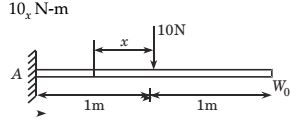
At left extreme of cantilever
σbending = 60 × 1 MPa = 60 MPa after 1 m
σbending = 60 × 0 MPa = 0 MPa and it will continue over whole span.
σ(bending stress) = Mxy = (10x)(0.005) N / m2 I (0.01)4 / 12
σbending = 60 x MPa (straight line equation)Correct Option: A
Here , I = bh3 = 0.01 × 0.013 m4 12 12
y = 0.005 m
At left extreme of cantilever
σbending = 60 × 1 MPa = 60 MPa after 1 m
σbending = 60 × 0 MPa = 0 MPa and it will continue over whole span.
σ(bending stress) = Mxy = (10x)(0.005) N / m2 I (0.01)4 / 12
σbending = 60 x MPa (straight line equation)
- A cyiindrical elastic body subjected to pure torsion about its axis develops
-
View Hint View Answer Discuss in Forum
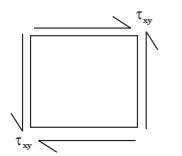
Pure torsion σx = σy = 0, τxy = τ
principle stressσ1 , 2 = σx + σy ± √ 

σx - σy 
² + τ²xy 
2 2
σ1 , 2 = ± τxy
So, angle of maximum principle stresstan(2θp) = 2τxy = ∞ σx - σy 2θp = π 2 θp = π or 45° 4
Correct Option: A

Pure torsion σx = σy = 0, τxy = τ
principle stressσ1 , 2 = σx + σy ± √ 

σx - σy 
² + τ²xy 
2 2
σ1 , 2 = ± τxy
So, angle of maximum principle stresstan(2θp) = 2τxy = ∞ σx - σy 2θp = π 2 θp = π or 45° 4
Direction: A massless beam has a loading pattern as shown in the figure. The beam is of rectangular crosssection with a width of 30 mm and height of 100 mm.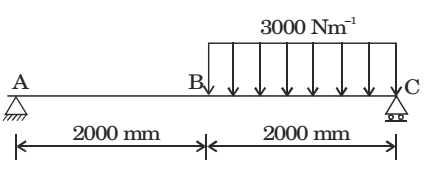
- The maximum bending moment occurs at
-
View Hint View Answer Discuss in Forum
RA = 1500 N
RB = 4500 N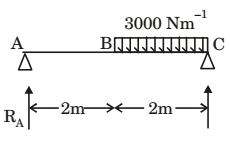
SF = RA –3000 (x–2)
SFx=2 = 1500 SFx=4 = –4500
SF = 1500 – 3000 (x–2) = 0 [For max BM]
x = 2.5 m
x = 2500 mm from A.Correct Option: C
RA = 1500 N
RB = 4500 N
SF = RA –3000 (x–2)
SFx=2 = 1500 SFx=4 = –4500
SF = 1500 – 3000 (x–2) = 0 [For max BM]
x = 2.5 m
x = 2500 mm from A.
- A concentrated load P acts on a simply supported beam of span L at a distance L/3 from the left support. The bending moment at the point of application of the load is given by
-
View Hint View Answer Discuss in Forum
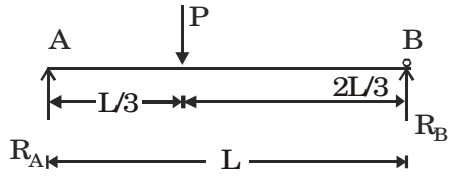
RA + RB =PRA = 2P 3 RB = P 3
BMx = RA x– P (x–L/3)BMx=L/3 = RA L - P 
L + L 
= RA L 3 3 3 3 BM = 2PL 9 Correct Option: D

RA + RB =PRA = 2P 3 RB = P 3
BMx = RA x– P (x–L/3)BMx=L/3 = RA L - P 
L + L 
= RA L 3 3 3 3 BM = 2PL 9

